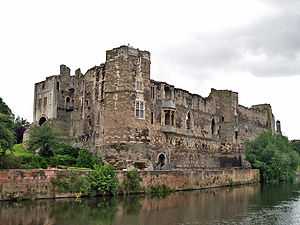Newark Castle, Nottinghamshire


Newark Castle, in Newark, in the English county of Nottinghamshire was founded in the mid 12th century by Alexander, Bishop of Lincoln. Originally a timber castle, it was rebuilt in stone towards the end of the century. Dismantled in the 17th century after the English Civil War, the castle was restored in the 19th century, first by Anthony Salvin in the 1840s and then by the corporation of Newark who bought the site in 1889. The Gilstrap Heritage Centre is a free-admission museum in the castle grounds about the history of the town of Newark.
History
In a charter generally thought to date to 1135, King Henry I granted the Bishop of Lincoln permission to build a castle.[1] The charter reads
Henry, King of England to all the Barons and to the Sheriffs and to his ministers and faithful men of Nottinghamshire, Greeting. Know ye, that I have granted to Alexander, Bishop of Lincoln, that he may make a ditch and rampart of his fishpond of Niwerc upon the Fosseway and he may divert the Fosseway through the same town as he shall wish.[2]
Alexander also established a mint at the castle.[3] This early castle was most likely of timber construction, and was rebuilt in stone towards the end of the century.[1] King John died at this castle on the night of 18 October 1216.[4][5]
The castle was slighted in 1648 and left derelict. Between 1845 and 1848 architect Anthony Salvin restored the castle, and in 1889 the corporation of Newark purchased the building and carried out further restoration work.[6]
The castle is a Scheduled Ancient Monument,[6] a "nationally important" historic building and archaeological site which has been given protection against unauthorised change.[7] It is also a Grade I listed building (first listed in 1950)[8] and recognised as an internationally important structure.[9] The Gilstrap Heritage Centre is located on the castle grounds. The centre features exhibits about the castle, and the town's history during the English Civil Wars. Admission is free.

References
- ↑ 1.0 1.1 Braun (1935)
- ↑ Quoted by Braun (1935)
- ↑ Pettifer (1995), pp.148 & 201
- ↑ Fryde, Greenway, Porter and Roy (1996), p.37
- ↑ Warren (1991), pp.254–255
- ↑ 6.0 6.1 "Newark Castle". Pastscape. English Heritage. Retrieved 3 May 2012.
- ↑ "Scheduled Monuments". Pastscape. English Heritage. Retrieved 3 May 2012.
- ↑ "Remains of Newark Castle". Heritage Gateway. Retrieved 3 May 2012.
- ↑ "Frequently asked questions". Images of England. English Heritage. Retrieved 3 May 2012.
- Bibliography
- Braun, Hugh (1935). "Notes on Newark Castle". Transactions of the Thoroton Society of Nottinghamshire 39: 53–91.
- Fryde, E. B., D. E. Greenway, S. Porter and I. Roy (eds) (1996) Handbook of British Chronology, third edition. Cambridge: Cambridge University Press. ISBN 0-521-56350-X.
- Pettifer, Adrian (1995). English Castles: A Guide by Counties. Woodbridge, UK: Boydell. ISBN 0-85115-782-3.
- Warren, W. Lewis. (1991) King John. London: Methuen. ISBN 0-413-45520-3.
External links
| Wikimedia Commons has media related to Newark Castle, Nottinghamshire. |
- Gatehouse Gazetteer record for Newark Castle, containing a comprehensive bibliography
- Newark Castle and gardens
- Newark Castle Contact Information
- YouTube video about the Gilstrap Heritage Centre and castle ruins
- Newark Castle and the River Trent; 2012 photographs